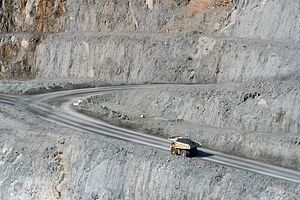Before departing for his trade and investment tour of North America, Australia’s Trade Minister Andrew Robb found himself addressing a familiar concern: Australia’s over-reliance on the Chinese economy for export growth.
Speaking to reporters on June 5, Robb said that “although a lot of the growth may come out of China,” long-term investors in the United States, United Kingdom, Switzerland and Japan “will continue to be the mainstay of our investment,” according to The Australian. The minister suggested that “we can’t put our eggs in the one basket,” implying that greater investment from these “long-term investors” balances out Australia’s overall investment position. But is that really the case?
Looking at the numbers, he may have a point. According to the Australian Bureau of Statistics, China’s foreign direct investment (FDI) in Australia, excluding Hong Kong, amounted to $4.7 billion ($4.4 billion) in 2013 (12.15 percent of the total). While still far from reaching either the United States ($17.54 billion) or the U.K. ($7.79 billion), China easily overshadows Robb’s first stopover of Canada, as well as the other two “mainstays” of Switzerland and Japan, all of which recorded annual declines in investment. In fact, FDI from China has increased dramatically in recent years, rising by more than four and a half times since 2008 and far outpacing our largest investor, the United States.
Taking a step back, however, the figures look a little less impressive. The total amount of Chinese direct investment in Australia is just $20.83 billion, or 3.31 percent of all FDI. Though starting from a low base, it hardly comes close to the countries at the top of the list: the United States (23.73 percent), the United Kingdom (13.76 percent) and Japan (10.04 percent). This also comes at a time when the race to attract Chinese investment is becoming much more globally competitive, according to a recent report by KPMG. As Chinese FDI transitions away from the mining sector, private companies start to expand globally in greater numbers, and medium and smaller sized projects become more common, there’s no guarantee that current trends will continue.
Australia received $249.5 billion of foreign investment in 2013 and has proven to be an attractive destination for global capital. But with China, a number of obstacles stand in the way of deepening the relationship.
The first is the perception in Beijing that Chinese companies aren’t always granted the same degree of freedom to invest in Australia as other countries. Of course, a lot of this has to do with the main source of investors, which in the case of China are largely state-owned enterprises (SOEs), raising concerns over security and strategic industries.
The current investment threshold for investments with “an interest in an Australian business” is $248 million, anything over which requires approval from the Foreign Investment Review Board (FIRB). In terms of the OECD’s FDI regulatory restrictiveness index, Australia is more ‘closed’ than the OECD average and ranks behind the U.S., U.K. and most European nations. But the real issue, according to ANU’s Peter Drysdale, is the largely ad-hoc nature of the FIRB’s investment guidelines on Chinese investment. He points to a number of proposed deals that have fallen through in recent years, such as Chinalco’s bid for Rio Tinto and Shenhua’s purchase of farmland in northern NSW, raising concerns in China about Australia’s investment regime.
The second obstacle is the public’s reaction to Chinese investment. In the 2014 Lowy Institute Poll, 56 percent of respondents thought that the Australian government was “allowing too much investment from China.”
Certain areas of the economy understandably remain politically sensitive, such as agriculture due to concerns over food security. But public misconceptions can also constrain the policy debate. A report from the Department of Agriculture, for instance, found that “foreign investment is likely to improve the food security of Australians” by boosting incomes and increasing agricultural production, though actual FDI levels remain quite low.
Some of these obstacles could come down sooner rather than later. According to an article in the Business Spectator, the $248 million investment threshold is likely to be raised to more than $1 billion if Australia concludes a Free Trade Agreement with China (which is currently the case for investment from New Zealand and the U.S. and recently extended to South Korea). Robb has also previously raised the possibility of relaxing investment rules for Chinese SOEs that have “a strong record in Australia.”
It will take strong action by the minister to correct misperceptions at home and to convince Beijing that the Australian government is committed to a larger role for Chinese investment. Only then can we expect China to become the same type of “long-term investor” as the United States or the United Kingdom.
































